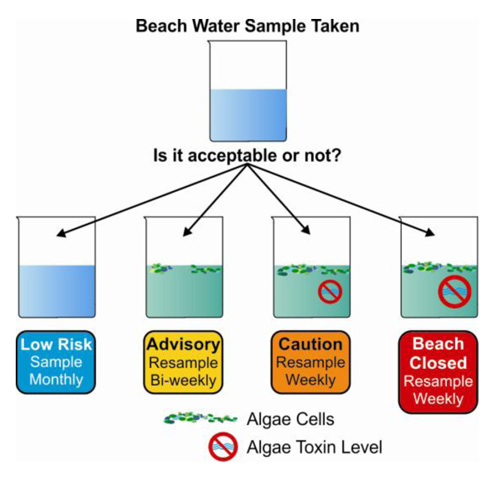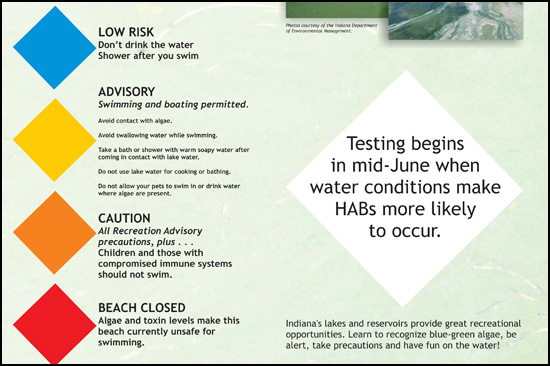Common questions about blue-green algae
What are blue-green algae?
Blue-green algae are a group of photosynthetic bacteria. They are most often blue-green in color, but can also be blue, green, reddish-purple or brown. When environmental conditions are just right, they can multiply quickly. Most species rise to the surface where they form floating mats but some stay suspended under the water’s surface.
What causes blue-green algae?
The nutrients that cause an algae “bloom” come from excess or misapplied lawn and agricultural fertilizers, runoff from pastures, feedlots, lawns and golf courses, discharges from non-regulated (residential) sewage treatment systems and many other sources of organic nutrients. Other factors that aid in the growth of algae include sunlight, warm weather, and low turbulence. According to the Indiana Department of Environmental Management (IDEM) algal blooms are most common from May to October but may occur at all times of the year.
Is all algae blue-green algae?
No. Many kinds of algae, most of which are microscopic and serve as an important supply of food for aquatic organisms, are found in Indiana lakes and streams. There are many types of blue-green algae too, and only 1/3 of them produce toxins. Toxins may be produced as part of the natural growth process of the algae and can be excreted into the water during growth or upon death.
Can blue-green algae make me sick?
Blue-green algae are capable of producing several different toxins. People may be exposed to these toxins through contact with the skin when swimming, inhalation when motor boating or water skiing or by swallowing contaminated water. Rashes, skin or eye irritation, and other uncomfortable effects such as nausea, stomach aches and tingling in fingers and toes may occur.
Can blue-green algae make my pet sick?
Animals are not necessarily more sensitive to blue-green algal toxins than humans. However, many animals enjoy being in the water. Animals may consume large quantities of algae if they drink the water. If blue-green algae happen to be producing toxin(s), the animals could become very ill. Symptoms may range from lethargy and loss of appetite to seizures, vomiting, and convulsions. Consumption of large quantities of the toxins could potentially cause death. Dogs are particularly susceptible because “scum” can attach to their coats and be swallowed during self-cleaning.
What does blue-green algae look like?
Blue-green algae can appear in a variety of forms. HABs have different colors and looks. Some colors are green, blue-green, brown, black, white, purple, red and black. They can look like film, crust or puff balls at the surface. They also may look like grass clippings or dots in the water. Some HABs look like spilled paint, pea soup, foam, wool, streaks or green cottage cheese curd.

Can I eat fish from water containing blue-green algae?
Some blue-green algal toxins can accumulate in the tissues of fish. Recent studies in Ohio have determined that the flesh of fish is safe to consume. The World Health Organization advises that if you eat fish taken from water where a blue-green algae bloom is present, eat them in moderation and avoid eating the guts, where accumulation of toxins may be greatest. Do not cut into organs when filleting, and rinse the fillets with clean water to remove any liquids from the guts or organs before freezing or cooking/p>
Are HABs a new problem?
No. Fossil evidence suggests that blue-green algae have been around for millions of years. Scientists have recorded blue-green algae blooms dating back to the 12th century and they have documented the toxic effects to livestock for more than 100 years. While it is important to remember that blue-green algae blooms have been present throughout history, recent blooms may have increased in frequency by the release of nutrients into our rivers, streams, and lakes.
Is our drinking water safe?
Yes. Water treatment processes remove any toxins from blue-green algae. Do not use lake water for cooking or bathing.
Do all Indiana lakes have this same problem?
Several agencies are working together to better understand blue-green algae blooms in our lakes including IDEM, the Center for Earth and Environmental Science at IUPUI, the Indiana Department of Health, the U.S. Army Corps of Engineers and the Indiana Department of Natural Resources Visual monitoring of many state-owned reservoirs and water sampling at many state beaches takes place during the summer. The beach sampling process follows this pattern:

Test results are posted at www.algae.IN.gov. Information signs are also posted at beaches that are being sampled, and if alert levels change because of an increase or decrease in indicators for blue-green algae, the appropriate colored diamond is placed in the white diamond-shaped space on the sign.

What can I do to help?
You can play a vital role in controlling algal blooms in nearby creeks, rivers, lakes, or reservoirs. Prevent blooms by limiting nutrient runoff. You and your neighbors can help in these ways:
- Do not over-fertilize. Most established lawns need few nutrients to be healthy. Check soil nutrient levels before you fertilize. Soil test kits can be purchased from local hardware stores and through online distributors.
- Use phosphorus-free lawn fertilizers. Lawn-fertilizer packaging is labeled with three numbers for nutrient content. Look for a zero as the middle number (phosphorus content) to indicate phosphorus-free fertilizer.
- Do not fertilize up to the edge of a waterway. Check with local governments for specific setback requirements.
- Do not dispose of grass clippings or leaves in or near a waterway.
- Have your septic system inspected and your tank pumped out at least every two years.
- Prevent soil and organic matter from washing into waterways and carrying excess nutrients into the drainage.
- Limit the use of aquatic weed control. These chemicals can have unintended consequences for algae development and the potential release of toxins and, therefore, not recommended.
- Look for local watershed initiatives in your area and participate.
